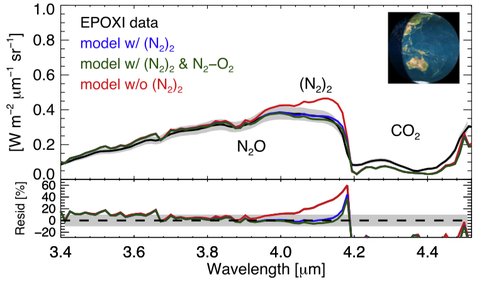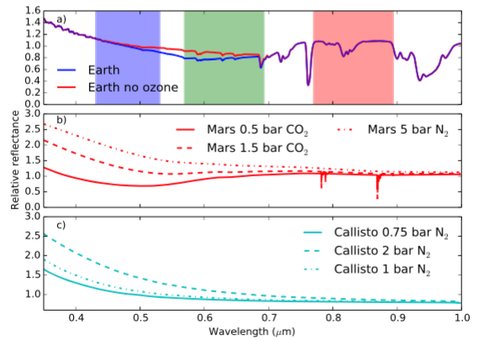2015 Annual Science Report
 VPL at University of Washington
Reporting | JAN 2015 – DEC 2015
VPL at University of Washington
Reporting | JAN 2015 – DEC 2015
Solar System Analogs for Exoplanet Observations
Project Summary
The worlds of our Solar System can provide an important testing ground for ideas and techniques relevant to characterizing exoplanets. In this task, we use observations and simulations of Solar System planets to understand how astronomers and astrobiologists will recognize signs of habitability and life in future observations of rocky exoplanets. Work in this area this past year includes the first-ever direct detection of molecular nitrogen collision-induced absorption in Earth’s whole-disk spectrum, which can be used to indicate atmospheric pressure and, thus, habitability. Also in this task, VPL scientists have proposed techniques for using color to distinguish Earth-like exoplanets from other types of worlds.
Project Progress
In this task we use observations of Solar System planets and moons to explore the detectability of signs of habitability and life on terrestrial planets. In Schwieterman et al. (2015), VPL team members made the first-ever detection of an absorption feature in Earth’s whole-disk spectrum due to molecular nitrogen (N2). This feature was found using comparisons between observations of Earth from NASA’s EPOXI mission and simulations from the VPL 3-D spectral Earth model. Molecular nitrogen can be a major constituent in planetary atmospheres, but is notoriously difficult to constrain. Thus, this work provides a new means for determining N2 concentrations in exoplanet atmospheres, which could be used to constrain surface habitability.
In other Solar System work, Glein et al. (2015) (including VPL team member Baross) used data from NASA’s Cassini mission and chemical models to constrain the pH of a sub-surface ocean on Saturn’s moon Enceladus, which is a key target of astrobiological interest due to its potential for originating and/or harboring life. This work suggests that Enceladus’ ocean has very alkaline pH, which could indicate active processes that provide an energy source for life. These results show how signatures of habitability and life from sub-surface environments could be remotely constrained.
In a modeling study of Titan, Charnay et al. (2015) explained the observed eastward propagation of dunes on this world’s surface. This work provides insights into volatile cycles on dry planets, as might occur for habitable worlds that form dry or lose most of their water.
Finally, in a VPL-led study, Krissansen-Totton et al. (2016) collated spectra of planets in our Solar System with a large number of VPL planetary spectral models to determine optimum filter bands for discrimination of Earth-like spectra from other planetary types. These authors found that, for exoplanet observations in which noise is dominated by dark current, planet color can provide an efficient means of preliminary characterization.
Publications
-
Charnay, B., Barth, E., Rafkin, S., Narteau, C., Lebonnois, S., Rodriguez, S., … Lucas, A. (2015). Methane storms as a driver of Titan’s dune orientation. Nature Geosci, 8(5), 362–366. doi:10.1038/ngeo2406
-
Glein, C. R., Baross, J. A., & Hunter Waite, J. (2015). The pH of Enceladus’ ocean. Geochimica et Cosmochimica Acta, 162, 202–219. doi:10.1016/j.gca.2015.04.017
-
Krissansen-Totton, J., Schwieterman, E. W., Charnay, B., Arney, G., Robinson, T. D., Meadows, V., & Catling, D. C. (2016). IS THE PALE BLUE DOT UNIQUE? OPTIMIZED PHOTOMETRIC BANDS FOR IDENTIFYING EARTH-LIKE EXOPLANETS. The Astrophysical Journal, 817(1), 31. doi:10.3847/0004-637x/817/1/31
-
Schwieterman, E. W., Robinson, T. D., Meadows, V. S., Misra, A., & Domagal-Goldman, S. (2015). DETECTING AND CONSTRAINING N 2 ABUNDANCES IN PLANETARY ATMOSPHERES USING COLLISIONAL PAIRS. The Astrophysical Journal, 810(1), 57. doi:10.1088/0004-637x/810/1/57
-
PROJECT INVESTIGATORS:
-
PROJECT MEMBERS:
Giada Arney
Co-Investigator
David Catling
Co-Investigator
Benjamin Charnay
Co-Investigator
David Crisp
Co-Investigator
Joshua Krissansen-Totton
Co-Investigator
Victoria Meadows
Co-Investigator
Edward Schwieterman
Co-Investigator
Jeremy Bailey
Collaborator
Amit Misra
Collaborator
-
RELATED OBJECTIVES:
Objective 1.2
Indirect and direct astronomical observations of extrasolar habitable planets.
Objective 2.2
Outer Solar System exploration
Objective 7.1
Biosignatures to be sought in Solar System materials
Objective 7.2
Biosignatures to be sought in nearby planetary systems


